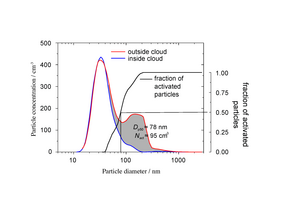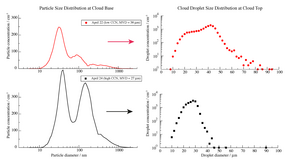
Fig. 1: Left Ordinate: aerosol number size distributions inside (blue) and outside (red) of clouds. Right Ordinate: fraction of activated particles (η, black line). Shaded area marks the number of activated particles (Nact).
Figure 1 shows an example of aerosol number size distributions measured inside (blue) and outside of clouds. While the outside cloud aerosol number size distributions show a bimodal distribution, typical for marine aerosols, the aerosol number size distributions inside clouds feature only a mono-modal distribution. Here, particles larger than approximately 80 nm in diameter are activated to cloud droplets. From the comparison of inside and outside cloud measurements the number of activated particles and 50% activation diameter (Dp,50) can be calculated. The above shown case was measured during the CARRIBA campaign in November 2010 over Barbados.

